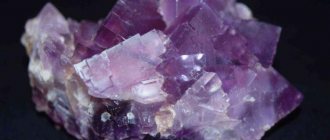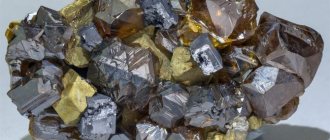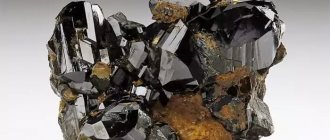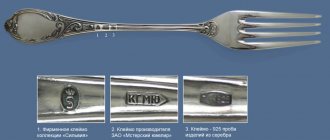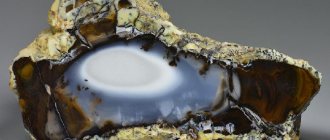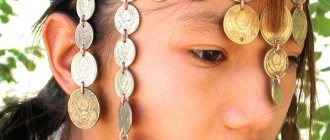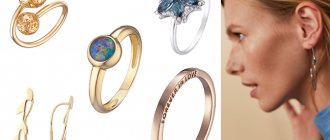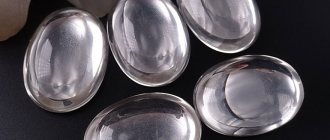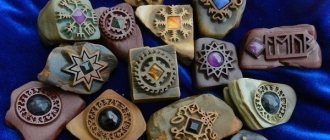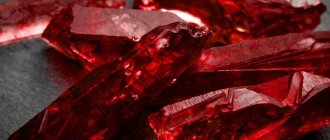Tatyana Gvozdenko, Ekaterina Gerasimova “Nature” No. 4, 2018
About the authors
| Tatyana Andreevna Gvozdenko - gemologist-analyst at the gemological-mineralogical laboratory of the State Geological Museum named after. V. I. Vernadsky RAS (GGM RAS). Area of scientific interests: mineralogy, gemology. |
| Ekaterina Igorevna Gerasimova - Candidate of Geological and Mineralogical Sciences, head of the gemological and mineralogical laboratory of this museum. The range of scientific interests covers issues of mineralogy and gemology. |
Gemology - the science of gems (jewelry stones) - began to take shape in the first half of the twentieth century. Of course, beautiful, bright and rare minerals have attracted people’s attention before, but researchers came to the need for their detailed (including analytical) study relatively recently.
Most scientists are of the opinion that gemology should be considered exclusively as an applied area of mineralogy, and not as an independent scientific discipline. The subject of the study of gemology are jewelry stones - minerals, a number of organogenic formations (amber, pearls, corals, bone, etc.), as well as synthetic (having natural analogues) and artificial (having no natural analogues) compounds grown in laboratory conditions under full control human (Fig. 1). The study of jewelry stones is closely related to other geological disciplines - mineralogy, crystallography, geochemistry, geology of mineral deposits, without the knowledge, understanding and application of which the role of gemology is reduced to a minimum.
Rice. 1.
Jewelry stones:
1
- aquamarine,
2
- amethyst,
3
- tanzanite,
4
- apatite,
5
- morganite,
6
- emerald,
7
- synthetic yellow sapphire,
8
- amethyst,
9
- sapphire,
10
- ruby,
11
- sphene,
12
- ruby,
13
- topaz,
14
- amethyst. Photo by T. A. Gvozdenko
INTRODUCTION
Gemology, designed to support the jewelry industry in the early stages of its development, became an independent scientific discipline at the beginning of the century from another geological science - mineralogy.
Conventionally, the beginning of the development of gemology can be considered 1902, when the French chemist M.A. Verneuil was the first to obtain and begin to supply synthetic rubies to the world market, and a little later synthetic sapphires and synthetic spinel. The appearance of a large number of synthetic stones has not reduced, but, on the contrary, increased the value and cost of natural, natural jewelry stones. According to the literature, over the past twenty years, the cost of jewelry diamonds has increased almost fourfold, and prices for natural emeralds and rubies often exceed the prices for diamonds. In recent years, gemology as an independent science has been developing especially intensively, since new, modern research methods have come to the aid of gemologists: radiography, adsorption optical spectroscopy, electron microscopy. There are several large gemological centers, the oldest of which, the Gemological Association of Great Britain, was created back in 1908.
Gemological instruments[edit]
Gemologists use a variety of tools and equipment that allow precise tests to be performed to identify a gemstone by its specific characteristics and properties.
Gemological travel laboratory KA52KRS
These include:
- Corrected 10x loupe
- Microscope
- Refractometer Polarizing filter
- Magnifying eyepiece
- Coupling fluid for RI (Refractive Index) up to 1.81
- Optical figure sphere
BASIC CONCEPTS OF GEMOLOGY. CLASSIFICATION OF JEWELERY AND ORINARY STONES
The close connection between gemology and mineralogy is determined by the fact that the vast majority of precious and ornamental stones are minerals. According to G. Smith, of more than 4 thousand known minerals, a third is directly used in jewelry, and the rest can serve as jewelry, ornamental, cladding, or exhibition and museum material. However, not all precious and semi-precious stones are minerals. By definition, a mineral is a naturally occurring chemical compound with a crystalline structure formed through various geological processes. Some natural amorphous formations - amber or volcanic glasses - are not minerals, but they are objects of study of gemology. Noble organic products: pearls, corals, jet, etc. do not belong to minerals. Finally, minerals are not gems obtained synthetically in laboratories and factories (a lot of them have appeared recently), but cubic zirconia, yttrium-aluminum and gallium-gadolinium garnets, synthetic diamonds, corundums, quartz and many other synthetic analogues of natural jewelry stones
The object of study of gemology is often only certain varieties of minerals that differ in some external feature, most often color, crystal shape, appearance and morphological characteristics. Two examples are illustrative.
Oddly enough, there is no generally accepted definition of the concept of “gem” today. Let us list the criteria by which precious stones are distinguished. There are three such criteria: beauty, durability and rarity; Unfortunately, all three criteria are conditional. It turns out that precious and ornamental stones include rare decorative minerals and rocks, which are characterized by a beautiful color or pattern, transparency, bright shine, which are often combined with each other. These stones are characterized by high strength and chemical resistance, which determines their aesthetic properties.
Let us list the main tasks of gemology:
— development of diagnostic criteria for natural and synthetic gems;
— introduction of new colored stones into jewelry and expanding the possibilities of using already known minerals;
— improvement of processes for refining jewelry and ornamental raw materials;
— creation of new synthetic analogues of minerals and jewelry and semi-precious stones, as well as improvement of technological schemes for the synthesis of existing gems.
In the process of development of gemology, many classifications of jewelry, ornamental and facing stones were proposed. Let's consider one of them - the classification of colored stones by E.Ya. Kievlenko, which is referred to by most Russian gemologists and the basis of which is the criterion for the cost of a gem. According to this classification, colored stones (gems) are divided into three groups:
— jewelry (precious) stones;
— jewelry and semi-precious stones;
- ornamental stones.
In turn, these groups are divided into orders.
First group
1st order: diamond, emerald, sapphire, ruby.
2nd order: alexandrite, noble jadeite, noble opal, orange, yellow, purple and green sapphire.
3rd order: demantoid, noble spinel, aquamarine, topaz, moonstone.
4th order: tourmaline, zircon, beryl, turquoise, amethyst, peridot, chrysoprase.
Second group
1st order: rock crystal, jadeite, jade, lapis lazuli, malachite.
2nd order: agate, amazonite, rhodonite, labradorite, belomorite, chalcedony.
Third group
Jasper, obsidian, selenite, fluorite, quartzite, flint, marble.
The length of the article does not allow us to list all the gems. More detailed information can be obtained from numerous literary sources, some of which are given at the end of the article. Some of the listed gems are shown in the photographs.
It should be remembered that this classification (as well as any other) cannot be considered universal. The cost of a colored stone is determined by many changing factors, such as fashion. In this regard, it is possible to move individual gems both down and up the classification orders of E.Ya. Kievlenko. Alexandrite is very indicative in this regard - a very rare variety of the mineral chrysoberyl (BeAl2O4), which changes its color depending on the nature of the light source. In recent years, many gemologists attribute alexandrite to the first order of the first group, estimating its value often higher than diamond, ruby, sapphire and emerald.
Literature:
- Bukanov V.V. Colored stones. Encyclopedia. On the RMO website
- Kievlenko E.Ya., Senkevich N.N., Gavrilov A.P. Geology of precious stone deposits. M.: "Nedra", 1982
- Suprychev V.A. Entertaining gemology: Essays on crafts. gems of Ukraine. Kyiv: Naukova Dumka, 1984. - 199 p.
- Suprychev V.A. Gems. (Gemmol. studies on cut stones of Ukraine). Kyiv: Nauk. Dumka, 1980. - 216 p.
- Suprychev V. A., Malkhasyan E. G. Gemological ideas of Armenians of the early Middle Ages (X-XII centuries). - Er. , 1980. - 200 p.
- Putolova L.S. Gems and colored stones. M.: Nedra, 1991
- Smith G. Precious stones. M.: Mir, 1984
- Elwell D. Artificial gems. M.: Mir, 1986
IMPROVEMENT AND IMPROVEMENT OF THE QUALITY OF JEWELERY AND ORINARY STONES
Rarity is a quality inherent in natural gemstones. Humanity has long sought to obtain gems artificially, as well as improve the quality of natural colored stones. However, only in our time has it become possible to artificially grow analogues of diamond, ruby, sapphire, emerald and other precious minerals. Some substances grown for technical purposes have also been successfully used in jewelry, for example, yttrium-aluminum and gallium-gadolinium garnets.
Synthesis of minerals is an interesting area of mineralogy. How is the quality of gemstone raw materials improved? Refinement of a jewelry and ornamental material is understood as the artificial improvement of its properties in order to enhance the jewelry and artistic and decorative qualities of gems. Most often, refining is associated with a change in the color of the mineral. People have been doing this since ancient times. During refining, honey, various ocher and red lead, copper sulfate, and primitive acids were used. With the development of chemistry, impregnation of minerals with chemical reagents has become commonplace. In modern times, after the discovery of radioactivity and X-rays, it was discovered that many gems have the ability to change color when exposed to ionizing radiation. Nowadays, gemology has accumulated extensive experience in the refining of mineral gemstone raw materials. For practical purposes, three types of effects are used to change the color of gems:
— impregnation with chemically active substances;
— thermal impact;
- ionizing radiation.
Let's consider each type of impact. A very successful example is the well-known turquoise gem. This complex copper phosphate (Cu(Al, Fe)6[PO4]4(OH)8 ii 4H2O), losing water, turns pale. Jewelers call this process turquoise aging. To avoid aging, in ancient times turquoise was impregnated with wax, paraffin, fat, and in our time - with colloidal silica, liquid glass, and various organic resins.
Agate, a cryptocrystalline, banded variety of quartz (SiO2), most often occurs in nature as gray sinter aggregates. To color agates, inorganic salts of chromium (green), iron (yellow), cobalt (blue), nickel, copper and other metals are used. Chemical impregnation of agates is often combined with temperature firing: in the old days, nondescript gray agates were kept in sugar syrup and then fired in ovens, resulting in wonderful onyxes with a contrasting color pattern. The agates painted by the old masters are almost impossible to distinguish from the best natural examples.
The quality of natural colored stones can be improved by heat treatment. Miners of the Urals, extracting morion crystals (a black variety of quartz) from the depths, baked them into dough and, as a result of firing, obtained beautiful yellow citrine crystals - undoubtedly a more valuable variety.
The author of this article has experience in refining natural sapphires (a blue variety of the mineral corundum (Al2O3)). Natural sapphires entering the world market from Indochina countries are often characterized by a too thick black-blue color, which significantly reduces their cost. Heating for several days at temperatures above 1000°C, as a rule, makes natural sapphires significantly lighter.
Ionizing radiation often leads to a change in the color of the gem in the opposite direction compared to heat treatment. Unfortunately, gems irradiated with radioactive chemical elements often become radioactive themselves. In gemological practice, g-irradiation units with the radioactive isotope 60Co are usually used. For example, topaz (Al2[SiO4](F, OH)) is a colorless, transparent mineral that, after irradiation, turns brown, blue or green, depending on the irradiation dose. Also diamonds, which when irradiated with radium salts turn green, when irradiated with neutrons - brown, and when irradiated in a stream of electrons - blue.
Gems are a beautiful creation of nature, which did not skimp on colors when creating them. Let us remember the words of Academician A.E. Fersman, a famous scientist and promoter of the aesthetics of the mineral world: “The future of stones is not in their value, not in the wealth invested in them, but in their beauty, in the harmony of colors, colors and shapes, in their eternity.” Gemology - the science of gems helps to deeply experience this harmony and beauty.
Source
Poems about gems
Exhibition of Gems of the World (Ode to Gems)
The exhibition “Sale of Gems of the World” often comes to us in Nizhny. I, like a somnambulist, am always in a hurry to find her exquisite light - looking for my talisman. Here are gems from distant countries: America, Peru, Albania, China. From the Arctic, shining with tender greenery, All surrounded by a blanket of snow, Vesuvian lies like the hand of spring. Strawberry quartz, so rosy-cheeked, lies flushed like a berry. Porous pyrite with iron crumbs came to our “Hermitage” from the Urals. Along the corridor, towards the exit from the hall, selenite is gilded like a transparent ball (It is a moonstone, it sharpens the senses). Here are my treasures! Their lilac silk captivates me, their mystery beckons, their dark burgundy flair In the twists of black: purple charoite, which quenches headaches, relieves insomnia, delusional sleep; A favorite of creative people, rhodonite - Gives faith, makes childbirth easier; And the austere beauty of eudialyte has recently captivated me. And next door - various souvenirs From onyx, agate, turquoise!.. From carnelians and aventurines Dishes, figurines and watches. And here, in front of a set of sapphires - Beryls, like drops of dew In a silver frame of a marvelous brooch; Garnets, like scatterings of peas, are enchanting - just stretch out your hand... In other trays - translucent tourmalines Mixed with olive jade. In the next room, if you look, you will see lapis lazuli with dumortierite (They are similar, like sadalite, Only the difference is in the shades and inclusions of Milk). What a pleasure it is for me to see you, my royal opal! Left India or crossed Nepal, Or maybe it was a long way from Australia Your journey was when a geologist found you, And later the jeweler gave you a frame, So that a fashionable businessman could decorate his neck or chest with you on a date. O stones, you keep the essence of What is called the universe: From your drawing, layers, Thick, rich, crystal-clear shades, you can predict, Find out what the earthly Building stands on And what providence could draw for us on the radiant yacht. Where are you from, O wonderful pilgrims, Keeping in your belly the beat of the earthly heart? Deep emerald crystals, lava played a scherzo for you before bed. From amethyst, druses are like bunches of grapes, And smooth cuts of stones - “tree rings”. Living precious communities, you are an abyss of years old, and you were taken from the abyss.
